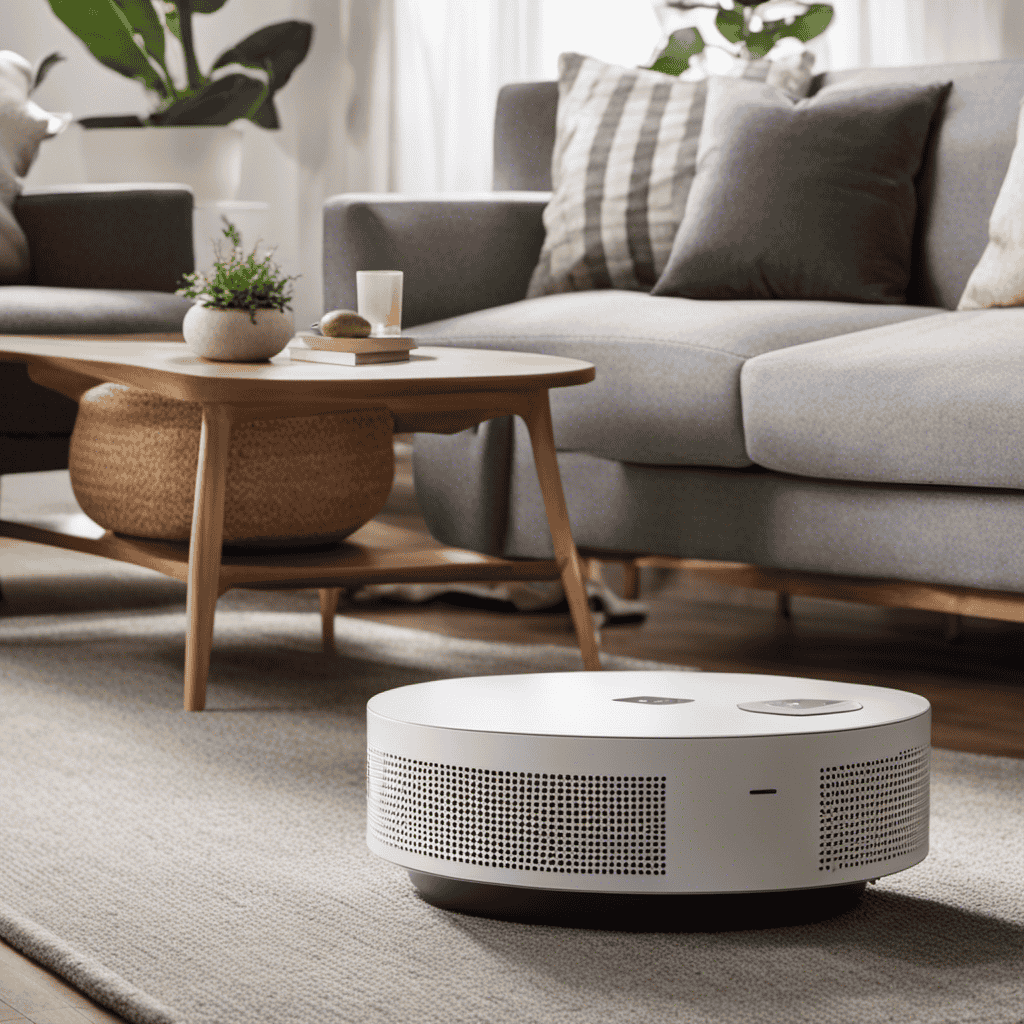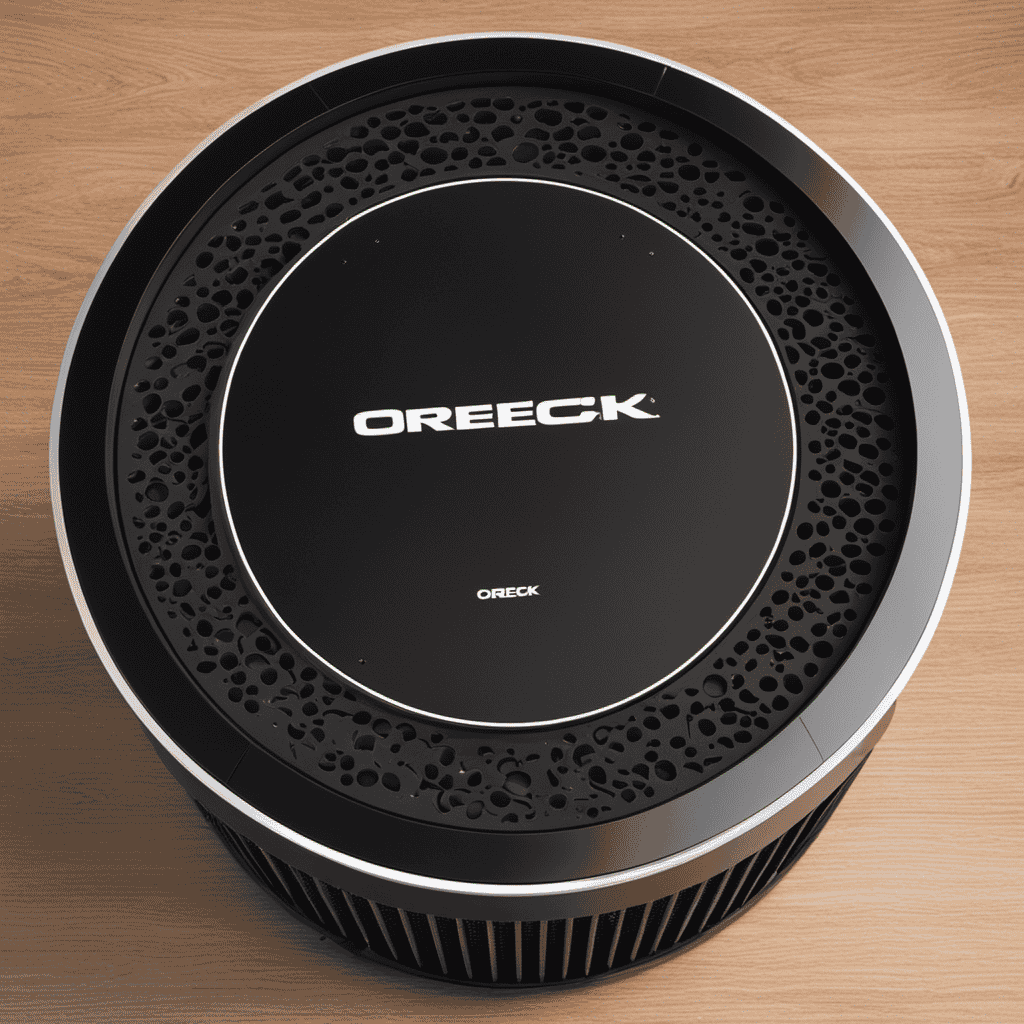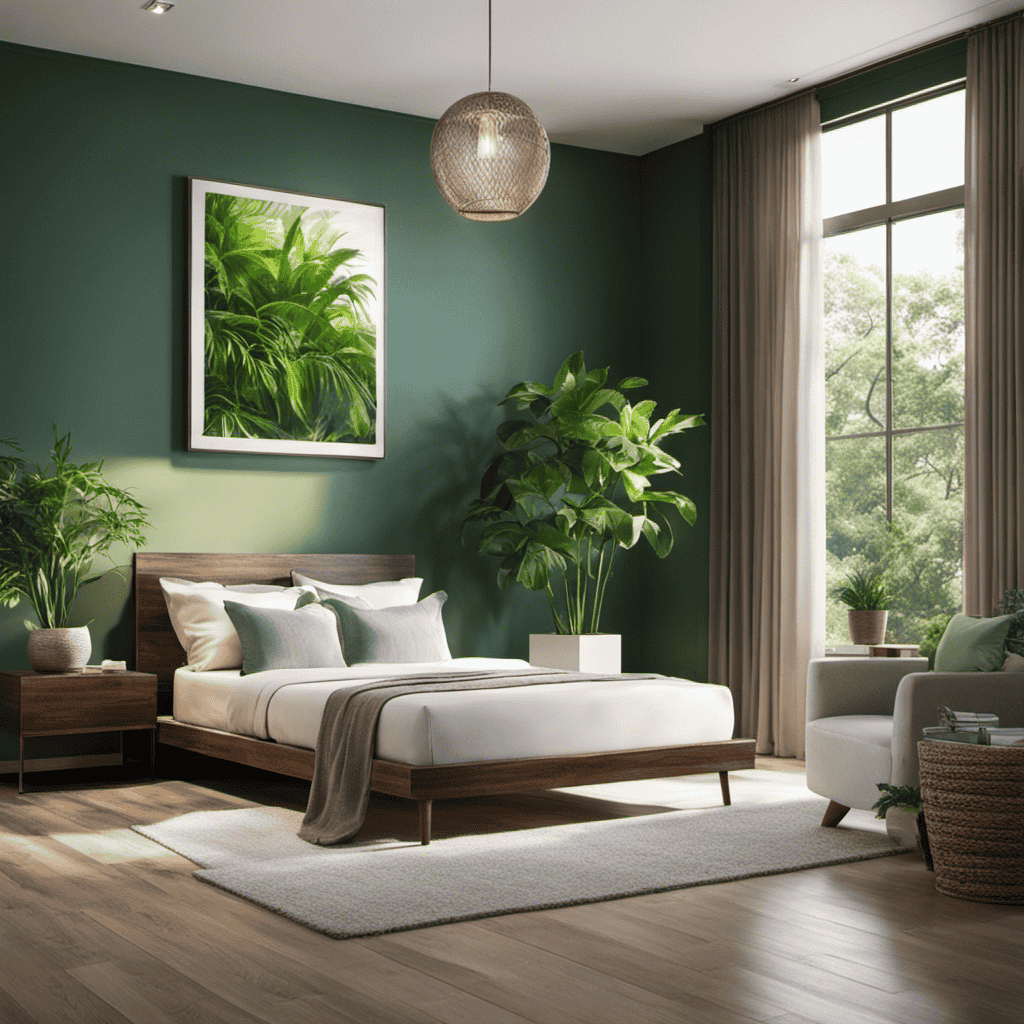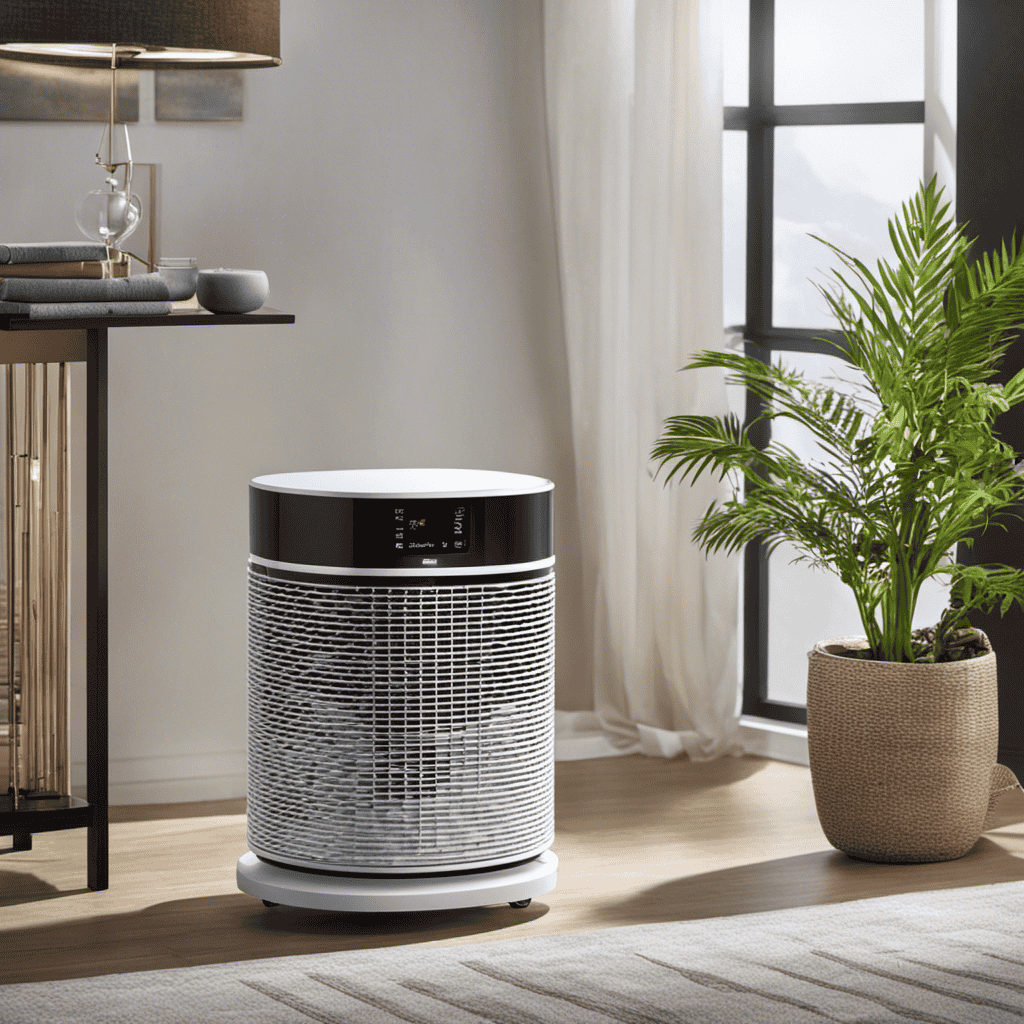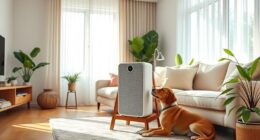Being someone who prioritizes health, I am always looking for ways to enhance the air quality in my household.
When it comes to tackling smoke, finding the best air purifier is essential. Like a vigilant guardian, it should effectively remove smoke particles and odors from the air.
In this article, we’ll explore the factors to consider when choosing a smoke air purifier, the importance of HEPA filters, and the features that make a purifier stand out.
Get ready to breathe easier and enjoy a smoke-free environment.
Key Takeaways
- Size of the space and type of smoke are important factors to consider when choosing an air purifier for smoke.
- HEPA filters are highly effective in removing smoke particles and are widely used in smoke air purifiers.
- CADR ratings are important in measuring the effectiveness of smoke air purifiers, and it is important to match the CADR rating to the room size.
- Other features to look for in a smoke air purifier include pre-filters for larger particles, activated carbon filters for smoke odors, coverage area, and noise levels and energy consumption considerations.
Factors to Consider When Choosing an Air Purifier for Smoke
When choosing an air purifier for smoke, you’ll want to consider factors like the size of your space and the specific type of smoke you need to filter out. Evaluating performance is crucial in ensuring that the air purifier effectively removes smoke particles from the air. Look for models with high Clean Air Delivery Rate (CADR) for smoke, as this indicates their ability to filter smoke particles efficiently.
Cost considerations are also important, as air purifiers for smoke can vary significantly in price. It’s important to find a balance between performance and cost that meets your specific needs. Understanding the different types of air purifiers for smoke will further assist you in making an informed decision.
Now, let’s delve into the various types of air purifiers for smoke.
Understanding the Different Types of Air Purifiers for Smoke
To understand the different types of air purifiers for smoke, you should consider factors such as filtration methods and coverage area.
When evaluating the performance of an air purifier for smoke, it is crucial to look at the filtration methods it utilizes. High-efficiency particulate air (HEPA) filters are considered the most effective for removing smoke particles from the air. Activated carbon filters are also essential as they can absorb odors and chemicals released by smoke.
Additionally, the coverage area of the air purifier is important to consider. You want to ensure that the purifier can effectively clean the air in the room or area where smoke is present.
Lastly, when comparing the cost of different air purifiers, it is important to consider the initial price, as well as ongoing maintenance costs, such as filter replacements.
The Importance of HEPA Filters in Smoke Air Purifiers
I’ve found that HEPA filters are crucial for effectively eliminating smoke particles from the air. These high-efficiency filters are designed to capture even the smallest smoke particles, ensuring cleaner and healthier indoor air.
The benefits of HEPA filtration extend beyond smoke removal, as they can also trap other harmful pollutants like allergens, dust, and pet dander, making them a valuable addition to any air purifier.
HEPA Filters Eliminate Smoke
HEPA filters can effectively eliminate smoke particles from the air. Here are four reasons why HEPA filters are highly effective in smoke filtration:
-
High Efficiency: HEPA filters can remove up to 99.97% of smoke particles as small as 0.3 microns in size, ensuring cleaner air quality.
-
Filtration Mechanism: HEPA filters use a dense mesh of fibers to trap smoke particles, preventing them from circulating back into the air.
-
Wide Application: HEPA filters can be used in various air purifiers, making them a versatile option for smoke filtration.
-
Alternative Methods: Compared to other smoke filtration methods like carbon filters or ionizers, HEPA filters are more efficient in capturing smoke particles.
With their high efficiency and wide application, HEPA filters are the preferred choice for effectively eliminating smoke particles from the air. Now let’s explore the benefits of HEPA filtration in more detail.
Benefits of HEPA Filtration
You’ll be amazed at the benefits of using HEPA filtration in your home or office. HEPA filters are designed to capture even the smallest particles, ensuring clean and smoke-free air. These filters have several features that make them highly effective in removing smoke particles from the air. First, the dense fiber structure of the filter traps smoke particles, preventing them from recirculating in the room. Second, the high-efficiency rating of HEPA filters ensures that over 99.97% of particles as small as 0.3 microns are captured. This means that even the tiniest smoke particles are removed, leaving you with fresh and healthy air.
| HEPA Filter Features | Benefits of Smoke-Free Air |
|---|---|
| Dense fiber structure | Improved respiratory health |
| High-efficiency rating | Reduced risk of lung cancer |
| Captures particles as small as 0.3 microns | Elimination of odors |
| Prevents recirculation of smoke particles | Cleaner indoor environment |
| Removes even the tiniest smoke particles | Enhanced quality of life |
HEPA filtration provides numerous benefits, from improved respiratory health to the elimination of odors. Now, let’s delve into evaluating CADR ratings for smoke air purifiers.
Evaluating CADR Ratings for Smoke Air Purifiers
When evaluating air purifiers for smoke, it’s important to consider the Clean Air Delivery Rate (CADR) ratings. CADR ratings measure the effectiveness of air purifiers in removing smoke particles from the air.
Here are four key factors to consider when evaluating CADR ratings:
-
Smoke CADR: Look for an air purifier with a high smoke CADR rating. This indicates that the purifier can efficiently remove smoke particles from the air.
-
Room Size: Consider the size of the room where you’ll be using the air purifier. Choose a purifier with a CADR rating that matches the room size to ensure effective purification.
-
Filter Efficiency: Evaluate the filter technology used in the air purifier. HEPA filters are highly effective in capturing smoke particles, so look for purifiers with HEPA filtration systems.
-
Energy Efficiency: Consider the energy consumption of the air purifier. Look for models that are energy-efficient to minimize your electricity bills.
Features to Look for in a Smoke Air Purifier
Consider evaluating the CADR ratings of different models to find the most effective smoke air purifier for your needs.
When comparing different smoke air purifier models, there are key features you should look for to ensure effective smoke air purification.
Firstly, a smoke air purifier should have a high-efficiency particulate air (HEPA) filter, capable of capturing small smoke particles and other pollutants.
Additionally, look for a purifier with a pre-filter that can trap larger particles and extend the lifespan of the HEPA filter.
Activated carbon filters are also important, as they can effectively remove smoke odors.
Another feature to consider is the air purifier’s coverage area, ensuring it can effectively clean the air in your desired space.
Lastly, consider noise levels and energy consumption when comparing models to find the best smoke air purifier for your specific needs.
Top-Rated Smoke Air Purifiers on the Market
There are several top-rated smoke air purifiers currently available in the market. To help you make an informed decision, here are four models that stand out in terms of purifier features and smoke removal methods:
-
Blueair Classic 605: This purifier boasts a high Clean Air Delivery Rate (CADR) and uses an advanced HEPASilent filtration technology to efficiently remove smoke particles from the air.
-
Coway Airmega 400: With its dual filtration system and activated carbon filter, this purifier effectively eliminates smoke odors and pollutants, providing clean and fresh air.
-
Rabbit Air MinusA2: This purifier features a six-stage filtration process, including a customized smoke filter, to tackle smoke and other harmful airborne particles.
-
Winix 5500-2: Equipped with a True HEPA filter and PlasmaWave technology, this purifier effectively captures and neutralizes smoke particles, ensuring a clean and healthy indoor environment.
These top-rated smoke air purifiers offer a range of advanced features and efficient smoke removal methods, making them excellent choices for improving indoor air quality.
Budget-Friendly Smoke Air Purifiers That Deliver Results
Looking for a smoke air purifier that fits your budget? Check out these affordable options that still deliver effective results. Investing in a smoke air purifier is essential for maintaining clean and healthy indoor air quality, especially for those who are sensitive to smoke particles. Here are some budget-friendly options that are worth considering:
| Brand | Price Range | Filter Type | Coverage Area |
|---|---|---|---|
| Honeywell | $100-$150 | HEPA & Carbon Filter | Up to 170 sq ft |
| Levoit | $80-$100 | HEPA & Activated Carbon Filter | Up to 219 sq ft |
| GermGuardian | $70-$90 | HEPA & Charcoal Filter | Up to 167 sq ft |
| Hamilton Beach | $60-$80 | HEPA & Carbon Filter | Up to 140 sq ft |
To ensure optimal performance and longevity of your smoke air purifier, regular maintenance is crucial. Here are some maintenance tips to keep in mind:
- Replace filters as recommended by the manufacturer.
- Clean the exterior and vents regularly.
- Keep the air purifier in a well-ventilated area.
- Avoid placing it near sources of smoke or excessive heat.
How to Properly Size an Air Purifier for Smoke
To properly size an air purifier for smoke, it’s important to know the square footage of the area you want to purify. Sizing considerations play a crucial role in ensuring the effectiveness of the purifier and maintaining proper ventilation. Here are four important factors to consider when sizing an air purifier for smoke:
-
Determine the square footage of the room: Measure the length and width of the room and multiply the two numbers to get the square footage.
-
Calculate the air changes per hour (ACH): ACH refers to the number of times the air in a room is completely replaced within an hour. For smoke removal, a higher ACH is recommended.
-
Consider the CADR (Clean Air Delivery Rate): CADR measures the purifier’s effectiveness in removing smoke particles. Look for a purifier with a CADR rating suitable for the square footage of the room.
-
Evaluate the purifier’s filtration system: Look for a purifier that uses a combination of activated carbon and HEPA filters to effectively capture smoke particles.
By considering these sizing considerations, you can ensure that your air purifier for smoke is properly sized to provide efficient and effective smoke removal.
Now, let’s explore the benefits of using an air purifier for smoke.
The Benefits of Using an Air Purifier for Smoke
I’ve found that using an air purifier for smoke can greatly improve indoor air quality.
Not only does it remove harmful particles and pollutants from the air, but it also helps to reduce health risks associated with smoke exposure.
Studies have shown that air purifiers can effectively capture and filter out smoke particles, making them a valuable tool for maintaining a healthier indoor environment.
Improved Indoor Air Quality
One option for improving indoor air quality is by using an air purifier specifically designed to filter smoke particles. Here are four reasons why investing in an effective air purifier can greatly benefit your health and well-being:
-
Reduction in respiratory issues: An air purifier effectively captures and removes smoke particles from the air, reducing the risk of respiratory issues such as coughing, wheezing, and asthma attacks.
-
Elimination of odors: Smoke particles can leave a lingering odor in your home. An air purifier helps eliminate these odors by trapping and neutralizing smoke particles, leaving your indoor environment smelling fresh and clean.
-
Removal of harmful chemicals: Smoke contains harmful chemicals that can pose serious health risks. An air purifier with activated carbon filters can effectively trap and remove these chemicals, improving the overall air quality in your home.
-
Enhanced overall well-being: Breathing clean air has numerous benefits for your overall well-being. It can improve sleep quality, boost productivity, reduce allergies, and prevent illnesses caused by poor indoor air quality.
Investing in an air purifier designed to filter smoke particles can significantly improve indoor air quality, providing you with the benefits of clean air and a healthier living environment.
Reduces Health Risks
Investing in an effective air purifier greatly reduces health risks associated with poor indoor air quality. By using a high-quality air purifier, you can significantly reduce respiratory symptoms and minimize exposure to harmful pollutants.
Research has shown that air purifiers are effective in removing particles such as dust, pollen, and smoke from the air. This is particularly important for individuals with allergies, asthma, or other respiratory conditions. Air purifiers work by capturing and trapping these particles, preventing them from circulating in the air and being inhaled. This can lead to a significant improvement in indoor air quality and a reduction in respiratory symptoms.
To ensure that your air purifier continues to work effectively, it is important to regularly maintain and clean it. Now, let’s explore some tips for maintaining and cleaning a smoke air purifier.
Tips for Maintaining and Cleaning a Smoke Air Purifier
To keep a smoke air purifier functioning effectively, it’s important to regularly clean and maintain it. Here are some tips for maintaining and troubleshooting a smoke air purifier:
-
Clean or replace the filters regularly: Smoke air purifiers have specialized filters designed to capture smoke particles. Clean or replace these filters according to the manufacturer’s instructions to ensure optimal performance.
-
Check the fan and motor: Over time, dust and debris can accumulate on the fan and motor, affecting their efficiency. Regularly inspect and clean these components to prevent clogs and ensure proper airflow.
-
Clean the exterior: Wipe down the exterior of the air purifier with a damp cloth to remove any dust or smoke residue. This will help maintain the appearance and functionality of the device.
-
Use recommended cleaning products: When cleaning your smoke air purifier, use cleaning products recommended by the manufacturer. Avoid using harsh chemicals or abrasive materials that could damage the device.
Can Air Purifiers Completely Eliminate Smoke Odor
If you’re wondering whether air purifiers can completely eliminate the odor of smoke, the effectiveness can vary depending on the size of the space and the type of purifier you choose. While air purifiers are helpful in removing smoke particles from the air, eliminating the cigarette smoke smell entirely may not be possible. However, using an air purifier specifically designed for smoke can significantly reduce the smell and improve the air quality in your home or office.
To illustrate the effectiveness of air purifiers in removing smoke smell, consider the following table:
| Air Purifier Type | Size of Space | Effectiveness in Removing Smoke Smell |
|---|---|---|
| HEPA | Small | Moderate |
| Carbon | Medium | High |
| Electrostatic | Large | Low |
As shown in the table, carbon-based air purifiers are the most effective in removing smoke smell, especially in medium-sized spaces. HEPA filters are also effective, but to a lesser extent. Electrostatic purifiers, on the other hand, are not as efficient in eliminating cigarette smoke odor.
Using Air Purifiers to Improve Indoor Air Quality During Wildfire Season
During wildfire season, using an air purifier can greatly improve the quality of indoor air. As someone who lives in an urban area, I understand the importance of maintaining clean air indoors. Here are four benefits of using air purifiers for allergies and improving air quality in urban areas:
-
Removal of particulate matter: Air purifiers are designed to capture and filter out fine particles in the air, such as smoke, pollen, and dust. This helps reduce the allergens that can trigger allergic reactions and respiratory issues.
-
Elimination of odors: Air purifiers equipped with activated carbon filters can effectively remove unpleasant smells, including smoke odor, leaving your indoor environment fresh and clean.
-
Reduction of airborne contaminants: Air purifiers can help reduce the concentration of pollutants such as volatile organic compounds (VOCs), which are commonly found in urban areas due to industrial activities and vehicle emissions.
-
Improved overall health: By removing allergens and pollutants from the air, air purifiers can help alleviate allergy symptoms, improve sleep quality, and reduce the risk of developing respiratory diseases.
Investing in a high-quality air purifier during wildfire season can make a significant difference in the air quality of your indoor space, providing relief for allergies and promoting better health.
The Connection Between Secondhand Smoke and Air Purifiers
Secondhand smoke can be effectively filtered out using an air purifier equipped with the right filters. Air purifiers are designed to remove particles and pollutants from the air, improving overall indoor air quality.
When it comes to secondhand smoke, the primary concern is the harmful chemicals and particles that are released into the air during smoking. These particles can linger in the air and pose a serious health risk, especially for those with respiratory conditions or compromised immune systems.
Do’s and Don’ts of Using Air Purifiers for Smoke
Using an air purifier equipped with the right filters can effectively filter out harmful particles and improve indoor air quality. When evaluating the performance and long-term effectiveness of air purifiers for smoke, there are a few key do’s and don’ts to keep in mind:
-
Do choose an air purifier with a high-efficiency particulate air (HEPA) filter. These filters are designed to capture small particles, including smoke particles, effectively.
-
Don’t forget to regularly clean or replace the filters. Over time, filters can become clogged and less effective at removing smoke particles from the air.
-
Do consider the size of the room when selecting an air purifier. Make sure the purifier is powerful enough to effectively clean the air in the space.
-
Don’t rely solely on an air purifier. It’s important to also address the source of the smoke and take steps to reduce or eliminate it.
By following these guidelines, you can maximize the performance and long-term effectiveness of your air purifier for smoke.
Now, let’s address some frequently asked questions about smoke air purifiers.
Frequently Asked Questions About Smoke Air Purifiers
When it comes to choosing an air purifier for smoke, it is important to consider the filter types available. HEPA filters are highly recommended as they are capable of capturing small particles and harmful smoke contaminants.
In terms of recommended purifier brands, popular options include Coway, Blueair, and Honeywell, which have been proven to effectively remove smoke particles and improve indoor air quality.
Filter Types for Smoke
The best air purifier for smoke typically utilizes a HEPA filter. HEPA stands for High Efficiency Particulate Air, and it is highly effective at capturing smoke particles and other pollutants in the air. There are different types of filters available for air purifiers, but not all of them are equally effective at removing smoke particles.
Here are four types of filters commonly used in air purifiers and their effectiveness in removing smoke:
-
HEPA Filter: HEPA filters are the most effective at removing smoke particles, with an efficiency of 99.97% for particles as small as 0.3 microns.
-
Activated Carbon Filter: Activated carbon filters are excellent at removing smoke odors and chemicals, but they are not as effective at capturing smoke particles.
-
Ionizer: Ionizers release negatively charged ions into the air, which attach to smoke particles and cause them to fall to the ground. While ionizers can help reduce smoke particles in the air, they do not remove them completely.
-
Electrostatic Precipitator: Electrostatic precipitators use an electrical charge to attract smoke particles to metal plates. While they can be effective at capturing smoke particles, they require regular cleaning to maintain their efficiency.
In conclusion, when it comes to removing smoke particles from the air, HEPA filters are the most effective option. However, other filters like activated carbon filters, ionizers, and electrostatic precipitators can also contribute to reducing smoke and its associated odors.
Now, let’s explore some recommended purifier brands that utilize these filters.
Recommended Purifier Brands
Now let’s take a look at some recommended brands that utilize these effective filters.
When it comes to finding the best air purifier for smoke, customer reviews play a crucial role in determining the top brands.
One highly recommended brand is the Coway AP-1512HH Mighty Air Purifier. This purifier has received numerous positive reviews from customers who have used it to effectively remove smoke particles from their homes.
Another popular brand is the Blueair Classic 605 Air Purifier. Known for its powerful smoke filtration capabilities, this purifier has received high praise from customers for its ability to eliminate smoke odors and improve indoor air quality.
Lastly, the RabbitAir MinusA2 Ultra Quiet HEPA Air Purifier is another top choice. With its comprehensive smoke filtration system, including a charcoal-based filter, it has garnered positive feedback from customers for its effectiveness in removing smoke particles.
Overall, these recommended brands have proven their worth through positive customer reviews.
Frequently Asked Questions
Can Air Purifiers Completely Eliminate Smoke Odor?
Yes, air purifiers can effectively eliminate smoke odor by removing harmful chemicals from the air. They are designed to capture and neutralize smoke particles, providing a cleaner and fresher environment.
How Do I Properly Size an Air Purifier for Smoke?
Properly sizing an air purifier for smoke involves considering the square footage of the room and the Clean Air Delivery Rate (CADR). Look for purifiers with HEPA filters and activated carbon filters for effective smoke removal.
What Are the Different Types of Air Purifiers for Smoke?
When it comes to air purifiers for smoke, it’s important to consider the different types of filters available. Each type has its pros and cons, and understanding them can help you make an informed decision.
How Do HEPA Filters Work in Smoke Air Purifiers?
HEPA filters in air purifiers for smoke provide several benefits for allergies. They effectively remove smoke particles, improving indoor air quality. HEPA filters trap small particles, reducing allergens and irritants in the air.
What Features Should I Look for in a Smoke Air Purifier?
When looking for a smoke air purifier, I consider air purifier brands and customer reviews. It’s important to find one with features like HEPA filters and activated carbon to effectively remove smoke particles and odors.
Conclusion
After carefully considering the factors and evaluating various options, I’ve come to the conclusion that the best air purifier for smoke is like a mighty warrior, fiercely battling against the invisible enemies lurking in the air.
Equipped with a powerful HEPA filter and a high CADR rating, it swiftly captures and eliminates smoke particles, leaving the air pure and fresh.
With its advanced features and ability to improve indoor air quality even during wildfire season, this air purifier is a true champion in the fight against smoke.

